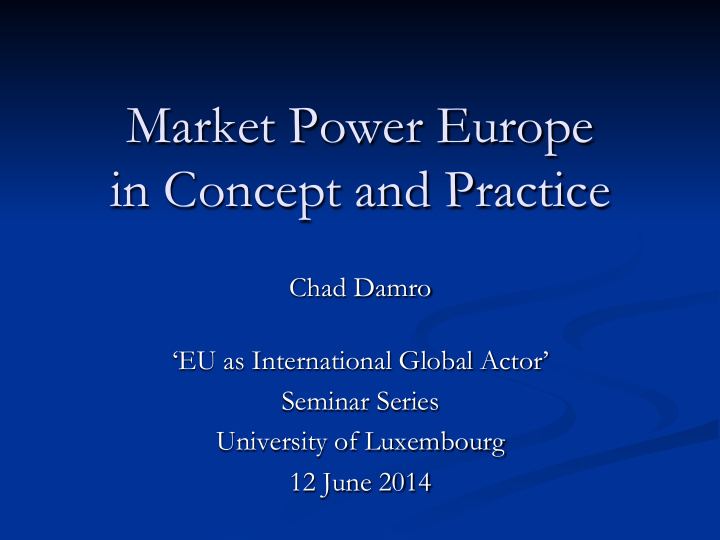



Market Power Europe in Concept and Practice Chad Damro ‘EU as International Global Actor’ Seminar Series University of Luxembourg 12 June 2014
EU As a Power Debates n If the EU is something new or sui generis , what kind of actor is it? n Small power, gentle power, superpower, quiet superpower, middle power, ethical power, risk-averse power, fragmented power, tranquil power, conflicted trade power, transformative power, and realist power
Civilian Power n EU Identity: As opposed to military power n Duchene (1972): EC is “long on economic power and relatively short on armed force” n EU able to achieve ‘civilian ends’ n How? n Non-military n Economic, diplomatic, and cultural policy instruments n Typically persuasive, not coercive
Normative Power Europe n Source of identity: rejection of nationalism, imperialism and war; unique character as ‘hybrid polity’; long-term development of values in Treaties and practices n EU Identity: 5 core norms and 4 minor norms n EU able to shape identities of non-members and change perceptions of what is ‘normal’ n How? n Contagion, informational diffusion, procedural diffusion, transference, overt diffusion and cultural filter
Alternative Basis for EU Identity n Historical development n ECSC, EEC, SEM, etc. n Present role in international system n Primary empirical context for EU n Fundamental basis for EU identity n Large regulated market
Market Power Europe n EU as Single Market n Size of market matters n EU as Regulator n Regulatory State n Regulatory Capacity n EU as Domestic Arena of Interest Contestation n Relative influence of interest groups and coalitions
How MPE Exercises Power n Externalisation n Attempt to get an actor to adhere to level of regulation similar to EU or behave in way that generally satisfies or conforms to EU’s market-related policies and regulations n Intentional/Unintentional n Persuasive/Coercive n Analytical problems n Focus on tools
MPE Tools q Positive Tools n Conclusion of trade, cooperation and association agreements n Tariff reduction, quota increase, granting inclusion in GSP n Providing aid, extending loans n Negative Tools n Delaying conclusion of agreements, suspending or denouncing agreements, withdrawing GSP n Embargo, boycott, tarriff increase, quota decrease n Reducing or suspending aid, delaying granting of successive loan tranches n Additional Tools
Evidence of MPE n What the EU is, says and does n Commission documents n 2001, 2006, 2007, 2010 n Trade policy as illustration n Cases
Potential Cases n COM: GSM, product safety, food safety, environmental protection, public procurement, financial regulation, accounting, piracy and counterfeiting, public health (tobacco control), maritime safety, automobiles n Ban on trade in Bluefin tuna n REACH/chemicals n Singapore Issue n Ban on unsafe airlines n WTO Disputes n Climate change n GMOs
Potential Cases n Cotonou Denial of Tariff Preferences n GSP+ Denial of Tariff Preferences n Kimberley Process n Trade in Timber n Ban on use of leghold animal traps and imports of furs from countries that do not have equivalent regulations n Ban on wildlife trade with Indonesia n Diplomatic and economic pressure to convince Norway and Canada to prohibit the killing of baby seals n Labour (including use of child and prison labour) n Data privacy/safe harbour agreement n Securities regulation
Conceptual Contributions n Utility of EU as Power debates n Key differences for MPE n Different identity (with key characteristics) n Coercion fundamental feature of MPE n MPE targets non-state actors n No problem of inconsistency
Market Power Europe and the Transatlantic Trade and Investment Partnership
Why does TTIP matter for MPE? n While this would be world’s largest trade agreement, regulatory matters are prominent in the negotiations. n TTIP is crucial case for MPE because US is an equally powerful actor in the area of trade. n If another actor has same characteristics, to what extent can/does EU externalise like MPE?
Outcomes n Market Size n Due to similar size of US market, MPE externalization occurs via coordination. n Regulatory Capacity n Similar levels of regulatory capacity and framework agreements encourage externalisation via process of policy adjustment (and MPE open to reciprocal externalization). n Interest Contestation n When/if pro-externalisation coalitions form, they tend to push for coordination instead of coercive externalization.
Conclusions n MPE as a conceptual framework n Plenty of policy areas to investigate n TTIP is a trade negotiation like no other for EU. n TTIP as next step of bilateral relationship and best way to address multilateral aspirations. n May we best conceive of EU as MPE?
Recommend
More recommend